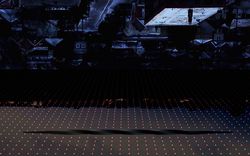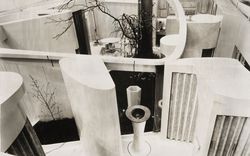2016: Brian Boigon Answers Joan Ockman and Phyllis Lambert
- Joan Ockman
- Just to pick up on what you’re starting to say… Where are we now? Looking back on this, is this a kind of nostalgia for this explosive, rupturing moment that has at this point become codified, and we’ve somehow absorbed it all, assimilated it, [so that] it no longer provokes us in the same way? Where are we now, and where are we heading?
- Brian Boigon
- That’s such an interesting question. Regardless of the kind of nostalgic aspect of this cacophonous environment and regardless of how much of it is bracketed by a spectrum of anxiety and production: I think where we are now is in a state of hyper-lamination fueled by social networking in the software fields of the internet, and that has produced a NEW space, a NEW urbanism, a NEW condition of the social. It’s so early—I barely got over working with Steve Bingham at Alias Research, who helped formulate the first algorithymic models for spline modelling, that Greg [Lynn] had echoed in his Indigo machines in the previous CCA exhibition on the Archaeology of the Digital. That’s a span of ten to twenty years ago.
So in twenty years—we are barely able to function in the digital and yet there’s a new layer, this social media layer. I think this social media layer, despite the tropes of it being superficial and…curiously problematic, there’s something in their networks and meshes that are producing a new kind of social space and temporality and we have to pay attention to this as architects. I think that there’s a role for us to incorporate in that world, and [for] urban designers…and spacemakers…. And it’s urgent to look there now since I think that’s a space that will become something. It’s nothing right now, it’s ridiculous, it’s not even fire. - Phyllis Lambert
- It just struck me, in your question… What were people in the Renaissance thinking of? They were going out in the fields and they were measuring these stones, and they were drawing them, and that was a new technology for them…there were new ways of looking at things, new spaces…
- BB
- Yeah, interesting.
- PL
- It’s interesting to try and think of that in relationship to what you’re talking about.
- BB
- Yeah, like a kind of disorientation under the culture of invention, where people don’t know where to place things?
- PL
- Yeah, exactly. They didn’t know what it was.
- BB
- I think that’s true for today…. In my opinion, the obsession with consolidation is just a reaction to complete and utter disorientation in the space. Change always sends out a host of resistors before it actually happens. No one’s controlling this space, and no one is paying attention. I mean everybody’s paying attention, but, really…the internet has changed everything. Absolutely everything. Every spatial and social relationship that you have in the world is now circumvented by the world wide web and by its new interoperable operating systems. And we have no idea, we’re not even at the telephone yet in that environment.
So I’m speculating on it, I continue to speculate on it. And I think to your point, Phyllis…I have two choices. To understand the present, you can go back, just like you did—let’s look at the Renaissance just for a minute—or you can go forward, go to the future, which is sort of what I’m doing now with the Interopera.1 I’m going five thousand years from now. I’m working with a nanophysicist to get the logic right. What does that look like, in order to see what this looks like. Just like how you would go historically back to see, I mean in a simplistic way. I think that’s the catapult of trying to locate yourself. I think location is one of the central existential problems of being able to make an ontological estimate on the digital present. We are here but really we are not here yet at all.
-
Interopera is a city created by Boigon in the sci-fi genre set five thousand years from now. The output of the project includes novels, drawings, computational models, sculptures, films, music, and data visualization games, among other formats. ↩
This exchange occurred as part of a question-and-answer session after a lecture by Boigon, which you can watch in full here. We invited Boigon to the CCA in the context of the exhibition The Other Architect. We also interviewed him about Culture Lab in the galleries, and we’ll publish that video soon.














